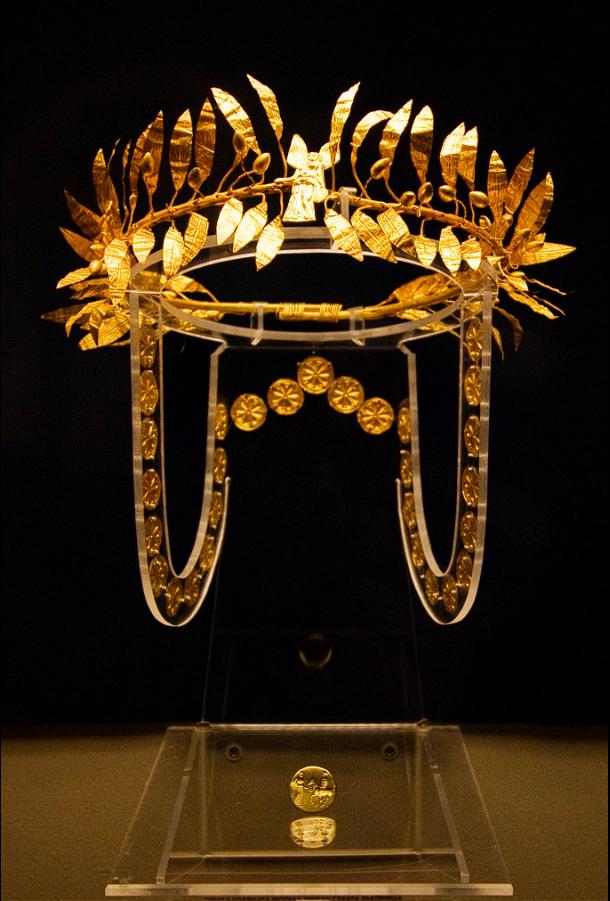The discovery of the golden wreath at Golyamata Mogila in Bulgaria offers a profound window into the opulent world of the Odrysian elite, revealing their wealth, artistic prowess, and complex social and ritualistic practices. 1 This artifact, dating back to the 4th century BCE, serves as a tangible link to a powerful Thracian kingdom, illuminating their sophistication and influence.

Unveiling Odrysian Power and Divine Connection:
The wreath’s design and context speak volumes about the Odrysian elite’s relationship with power and the divine.
Symbolism of Victory and Divine Favor:
- The prominent depiction of Nike, the goddess of victory, on the wreath underscores the Odrysian elite’s association with triumph and divine favor.
- This suggests a desire to project an image of invincibility and to legitimize their rule through divine endorsement.
- The divine connection, shows a society that looked to the gods, for guidance.
Ceremonial and Ritualistic Significance:
- The intricate craftsmanship and delicate gold chains indicate that the wreath was a ceremonial object, likely worn during significant events and rituals.
- It might have adorned the heads of Odrysian nobles during processions, religious ceremonies, or other public displays of power.
- The wreath, was a way to show status, during important events.
Funerary Rituals and Afterlife Beliefs:
- Its discovery within a burial mound suggests that the wreath also served as a funerary offering, intended to accompany the deceased into the afterlife.
- This practice reflects the Odrysian belief in an afterlife and the desire to provide the deceased with symbols of their status and wealth.
- The placement of the wreath, shows the respect given to the dead.
A Testament to Odrysian Wealth and Artistic Mastery:
The wreath’s exquisite craftsmanship highlights the Odrysian elite’s wealth and the exceptional skill of their artisans.
Opulence and Material Wealth:
- The use of gold, a precious and highly valued material, underscores the Odrysian elite’s access to vast resources and their penchant for luxury.
- It signifies their ability to commission exquisite works of art, demonstrating their wealth and power.
- The use of gold, was a way to show off, and to show power.
Advanced Metalworking Skills:
- The intricate design and finely crafted discs on the wreath demonstrate the remarkable metalworking skills of Thracian artisans.
- Their ability to create such delicate and complex objects rivals that of their Greek and Persian contemporaries, challenging the notion of Thracian cultural inferiority.
- The level of craftsmanship, shows a highly advanced culture.
Cultural Exchange and Influence:
- The stylistic influences, particularly the depiction of Nike, suggest cultural exchange between the Odrysians and their Greek neighbors.
- This indicates that the Odrysian kingdom was not isolated but rather part of a broader network of cultural interaction.
- The exchange of ideas, helped to shape the Odrysian culture.
Insights into Odrysian Elite Culture and Society:
The wreath provides valuable insights into the social structures and cultural values of the Odrysian elite.
Hierarchical Social Structure:
- The discovery of such a lavish artifact in a noble’s burial mound reinforces the notion of a hierarchical society, with a powerful and wealthy elite class.
- It highlights the stark contrast between the elite and the common people, reflecting the social stratification of the Odrysian kingdom.
- The differences in burial goods, reinforces the class system.
Emphasis on Status and Public Display:
- The wreath’s function as a symbol of power and prestige indicates the Odrysian elite’s emphasis on status and public display.
- They sought to project an image of grandeur and authority, both in life and in death.
- The showing of power, was a large part of the Odrysian culture.
Ritualistic Practices and Beliefs:
- The placement of the wreath within a burial mound highlights the importance of ritualistic practices and beliefs related to the afterlife.
- These rituals served to reinforce social order and ensure the deceased’s passage into the next world.
- The belief systems, helped to shape the Odrysian culture.
The golden wreath of Golyamata Mogila is more than just a beautiful object; it is a historical document that illuminates the wealth, artistry, and cultural complexity of the Odrysian elite. It serves as a reminder of the rich and diverse civilizations that once thrived in ancient Thrace.

CÁC TIN KHÁC
Mary Walton: The Forgotten Inventor Who Helped Clean Up America’s Cities
Tomb of Queen Nefertari in the Valley of the Queens, Egypt
Discover the Hypostyle Hall of the Temple of Hathor at Dendera
Venus de Losange: Unveiling the Mystery of a 20,000-Year-Old Paleolithic Icon